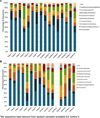The potential role of lung microbiota in lung cancer attributed to household coal burning exposures
- PMID: 24895247
- PMCID: PMC4217127
- DOI: 10.1002/em.21878
The potential role of lung microbiota in lung cancer attributed to household coal burning exposures
Abstract
Bacteria influence site-specific disease etiology and the host's ability to metabolize xenobiotics, such as polycyclic aromatic hydrocarbons (PAHs). Lung cancer in Xuanwei, China has been attributed to PAH-rich household air pollution from burning coal. This study seeks to explore the role of lung microbiota in lung cancer among never smoking Xuanwei women and how coal burning may influence these associations. DNA from sputum and buccal samples of never smoking lung cancer cases (n = 8, in duplicate) and controls (n = 8, in duplicate) in two Xuanwei villages was extracted using a multi-step enzymatic and physical lysis, followed by a standardized clean-up. V1-V2 regions of 16S rRNA genes were PCR-amplified. Purified amplicons were sequenced by 454 FLX Titanium pyrosequencing and high-quality sequences were evaluated for diversity and taxonomic membership. Bacterial diversity among cases and controls was similar in buccal samples (P = 0.46), but significantly different in sputum samples (P = 0.038). In sputum, Granulicatella (6.1 vs. 2.0%; P = 0.0016), Abiotrophia (1.5 vs. 0.085%; P = 0.0036), and Streptococcus (40.1 vs. 19.8%; P = 0.0142) were enriched in cases compared with controls. Sputum samples had on average 488.25 species-level OTUs in the flora of cases who used smoky coal (PAH-rich) compared with 352.5 OTUs among cases who used smokeless coal (PAH-poor; P = 0.047). These differences were explained by the Bacilli species (Streptococcus infantis and Streptococcus anginosus). Our small study suggests that never smoking lung cancer cases have differing sputum microbiota than controls. Further, bacteria found in sputum may be influenced by environmental exposures associated with the type of coal burned in the home.
Keywords: 16S; bacteria; carcinogenesis; lung cancer; lung microbiota; pulmonary; respiratory.
© 2014 Wiley Periodicals, Inc.
Conflict of interest statement
Conflicts of interest: None to declare.
Figures



References
-
- Backhed F. Host responses to the human microbiome. Nutr Rev. 2012;70(Suppl 1):S14–S17. - PubMed
-
- Chapman RS, Mumford JL, Harris DB, He ZZ, Jiang WZ, Yang RD. The epidemiology of lung cancer in Xuan Wei, China: Current progress, issues, and research strategies. Arch Environ Health. 1988;43:180–185. - PubMed
Publication types
MeSH terms
Substances
Grants and funding
LinkOut - more resources
Full Text Sources
Other Literature Sources
Medical

